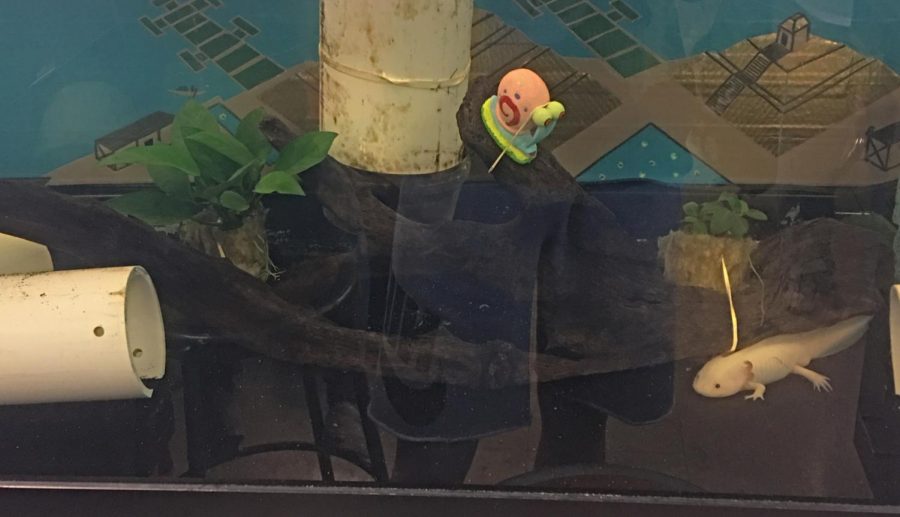Younkin Intrigues Students with Axolotls
October 9, 2018
AP Biology teacher Kerri Younkin has creatures that most students never have heard of or seen before -axolotls.

Photo by Lucas Dimler
Younkin read about these creatures online years ago, and she heard about them in observation discussion rooms that she was part of. In her last workplace the staff decided to have some animals in the classroom for students to look at, and one of the other instructors had an interest in axolotls, allowing her the chance to work with them for the first time.
Younkin got the axolotls “from a reader of Washington state, and some came from Towson University.”
The axolotls require a specific diet in order to live.
“They are carnivores, and the adults primarily eat carnivores’ pellets that you can get for salamanders, or I can just feed them frozen blood worms that I thaw out,” said Younkin.
Axolotls have been described as friendly and even playful at times.
“I find them to be really friendly,” said Younkin. “They were all hand fed for a long time, so they will actually eat if you have food and put a little glove on your hand, and they will actually come to the surface and eat out of your hand. If they get the glove, they don’t mean to. They are not super coordinative; sometimes they actually get more than just the food your trying to feed them. The darker one will actually play with you for a little bit, and say ‘hey’ what’s going on,’ so I find them to be friendly.”
Younkin warns students of the danger of sticking your hands in the tank.
“That could be a bad thing; for the student, nothing would happen. The Axolotls would just ignore or keep swimming unless if you had food in your hand,” said Younkin. “For the axolotls, they are salamanders, and they breathe through their skin, and they also absorb water through their skin and so any chemicals that might have been on the student’s hand, like hand lotion, could end up in the tank and can get absorbed by the axolotls, and it could hurt the axolotls, so that would be a bad thing.”
Younkin also mentions where most axolotls came from.
Axolotls are located in a lake system from Mexico called lake Xochimilco.
Younkin says that the axolotls are amphibians like salamanders, but do not come out of the water because their gills are outside of their body.
Younkin talks about the different color of axolotls.“There are a number of different coloration patterns that you can find in Axolotls,” said Younkin. “I have two different coloration patterns here. One is called leucistic; those are the white ones, and the other one is a wild type, but there is also a golden albino axolotl. There are a couple different ones out there.”
Younkin sees the axolotls as a unique pet.“They aren’t my favorite animal to have as pets, but they are my favorite aquatic animal; dogs edge out the axolotls,” said Younkin.

Photo by Lucas Dimler
Senior Brody Cain was intrigued by the creatures.
“[I] thought they were pretty cool, weird looking, different, not the typical goldfish,”said Cain.“Probably the fact that they are endangered species and come from Central America.”
Cain cleans the tanks about twice a week and would get the axolotls as a pet if he had the choice.
Junior Natalie Thomas was surprised by them.
“I was not expecting it at all, so it was kind of crazy especially since there were so many,” said Thomas.“I think they’re very unique since they’re native to Mexico, so I have never heard of them before I joined Mrs.Younkin’s class.”
Thomas cleans the tanks and helped out since there are so many.



